
The Battle of Fleurus, on 26 June 1794, was an engagement during the War of the First Coalition, between the army of the First French Republic, under General Jean-Baptiste Jourdan, and the Coalition army, commanded by Prince Josias of Coburg, in the most significant battle of the Flanders Campaign in the Low Countries during the French Revolutionary Wars. Both sides had forces in the area of around 80,000 men but the French were able to concentrate their troops and defeat the First Coalition. The Allied defeat led to the permanent loss of the Austrian Netherlands and to the destruction of the Dutch Republic. The battle marked a turning point for the French army, which remained ascendant for the rest of the War of the First Coalition.

The Battle of Denain was fought on 24 July 1712 as part of the War of the Spanish Succession. It resulted in a French victory, under Marshal Villars, against Dutch and Austrian forces, under Prince Eugene of Savoy.

The arrondissement of Douai is an arrondissement of France in the Nord department in the Hauts-de-France region. It has 64 communes. Its population is 245,280 (2016), and its area is 476.6 km2 (184.0 sq mi).
André Souris was a Belgian composer, conductor, musicologist, and writer associated with the surrealist movement.
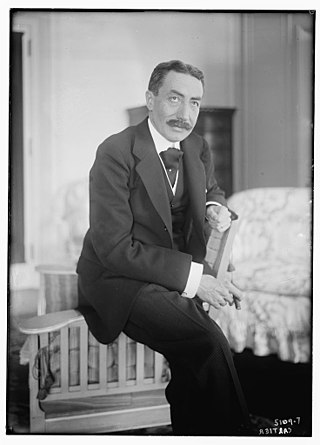
Baron Emile-Ernest de Cartier de Marchienne was a Belgian diplomat who was ambassador to a number of countries, most principally the United States and the United Kingdom.

The siege of Bouchain, following the Passage of the Lines of Ne Plus Ultra, was a siege of the War of the Spanish Succession, and the last major victory of John Churchill, 1st Duke of Marlborough. Marlborough and François Nicolas Fagel broke through the French defensive lines and took Bouchain after a siege of 34 days. Its capture left Cambrai the only French-held fortress between the allied army and Paris.
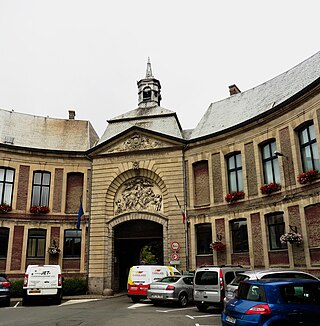
Marchiennes is a commune in the Nord department in northern France. It was fictionally portrayed in Émile Zola's Germinal.
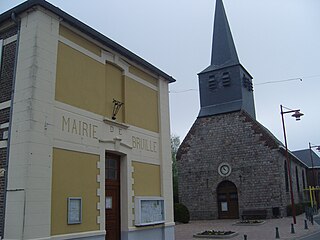
Bruille-lez-Marchiennes is a commune in the Nord department in northern France.
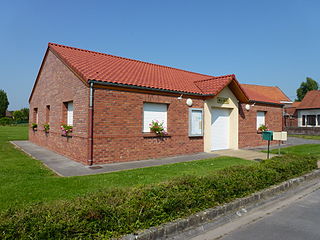
Tilloy-lez-Marchiennes is a commune in the Nord department in the Hauts-de-France region, Northern France. In 2018, it had a population of 516.
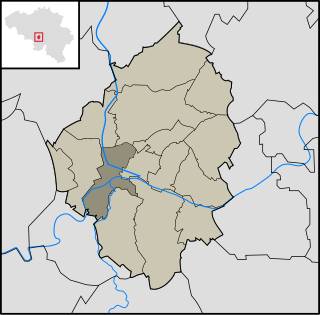
Marchienne-au-Pont is a town of Wallonia and a district of the municipality of Charleroi, located in the province of Hainaut, Belgium.
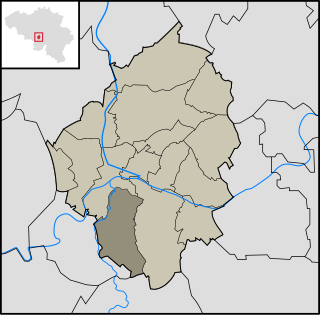
Mont-sur-Marchienne is a town of Wallonia and a district of the municipality of Charleroi, located in the province of Hainaut, Belgium.
Rudolf Ritter von Otto began his military career in the army of the Electorate of Saxony, transferred to the Austrian army and had a distinguished combat record during the Seven Years' War and the French Revolutionary Wars.
Cartier Castle is a château in Marchienne-au-Pont, a district of Charleroi, in the province of Hainaut, Wallonia, Belgium.

Marchiennes Abbey was a French monastery located on the Scarpe in Marchiennes. It was founded around 630 by Adalbard of Douai, and Irish monks, disciples of Saint Columbanus, on the advice of Saint Amand. One of its founders was Rictrude, who made it double monastery in 643. In around 1024 it became monastery of men again and adopted the Benedictine rule. On the birth of the town of Marchiennes the abbey became its economic motor until being suppressed in 1791 during the French Revolution. In 1814 all but its 1748 gatehouse was demolished. Its remains were inscribed on the inventory of monuments historiques on 17 May 1974,

De Cartier is a Charleroi Metro station, located in the center of Marchienne-au-Pont, in fare zone 2. It is an underground station featuring a central platform with escalator and stairs access at both ends.

The Battle of Gosselies or Battle of Charleroi saw a Republican French army co-commanded by Jacques Desjardin and Louis Charbonnier try to cross the Sambre River against a joint Dutch and Habsburg Austrian army under William, Hereditary Prince of Orange. The French defeat in the battle marked the third of five attempts by their armies to win a foothold on the north bank of the Sambre during the War of the First Coalition. In 1794, Gosselies was a separate village but is now part of the Charleroi municipality, about 7 kilometres (4 mi) north of the city center. Charleroi is located about 60 kilometres (37 mi) south of Brussels.

The Battle of Lambusart saw a Republican French army led by Jean Baptiste Jourdan try to cross the Sambre River against a combined Dutch and Habsburg Austrian army under William V, Hereditary Prince of Orange. This battle was the culmination of the fourth of five attempts to consolidate a foothold on the north side of the Sambre. The clash occurred during the War of the First Coalition, part of a wider struggle known as the Wars of the French Revolution. In 1794, Lambusart was an independent village, but it is now part of the Fleurus municipality. Lambusart is located about 10 kilometres (6 mi) northeast of Charleroi.
The canton of Sin-le-Noble is an administrative division of the Nord department, northern France. It was created at the French canton reorganisation which came into effect in March 2015. Its seat is in Sin-le-Noble.

The siege of Bouchain, was a siege of the War of the Spanish Succession, and a victory for the French troops of the Duc de Villars. A French army of 20,000 men besieged and captured the Allied-controlled fortifications after an 18-day siege, with the 2,000-strong Dutch-Imperial garrison under Major-General Frederik Sirtema van Grovestins capitulating on 19 October.

The word lès is an archaic French preposition meaning "near", "next to". Today it occurs only in place names to distinguish places of the same name.















